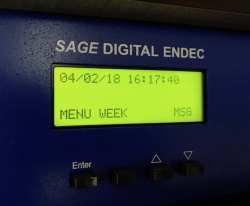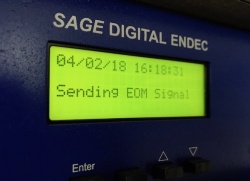Difference between revisions of "DJ Training Part 3: EAS, Legal Stuff and the FCC"
| Line 93: | Line 93: | ||
[[Category:Radio]] | [[Category:Radio]] | ||
| + | [[Category:DJ Training]] | ||
| + | [[Category:Production]] | ||
Latest revision as of 20:59, 9 December 2020
Contents
General Help & Answers
Emergency Contact info is posted via label tape on the computer monitors in Air1, Air2 and Prod 1.
Additional information is available on the KDHX Intranet site - please note that it is not available to the general public, but only to users while in the KDHX facility.
To report these non-emergency issues, e-mail:
- - Facility/Equipment: techsupport [at] kdhx.org
- - 'Underwriting spot played late, early or missed: underwriting [at] kdhx.org
The KDHX Intranet also offers:
- Our Internal Blog containing most recent Staff-to-Volunteer communications about upcoming events, parties, state of the organization & fundraising initiatives, drive dates ands recaps, etc.
- FCC compliance guidelines for airing multiple songs by the same artist, indecent/obscene material, etc.
- Helpful links to FAQs, the free tickets for volunteers form, the current volunteer producer contract, staff tech and security support info, etc.
Emergency Alert System (EAS)
Our Emergency Alert System (EAS) has been upgraded to Digital, and has moved down the air chain, which means it is less of a burden on the show host/DJ. EAS message logging relay required events are no longer the responsibility of the host/DJ, but are handled automatically by the system.
Events triggered by the EAS system from the NWS (National Weather Service) will take over our air signal as required by law, but will not be aired on our online stream. This means that in the Air studio where you’re doing your show, you will not hear weather events passed through the EAS system and the subsequent FM Air signal.
Tips you should know:
- Being that the EAS message is only intended for the local / STL area audience, it will not pass through our online stream and TuneIn mobile app signal. With this in mind, you should continue programing your show normally during EAS events, assuming your online listenership is listening as usual. No need to interrupt the program for local-only weather events.
- When an EAS event begins, the red light on the Air 1 alert pole will flicker, and the SAGE ENDEC (blue rack device near the top) will begin displaying related information. The on-screen countdown will let you know when the message will begin airing and when it has completed
Standard /After MSG:  During EAS Event:
During EAS Event: 
- Avoid doing any verbal announcing or airing any underwriting during the alert airing, as it will not be heard locally. Just keep on spinning music through it.
- On occasion, a Weekly Required Test (WRT) of our EAS system will be scheduled for your show. In these occasions, a staff member will inform you in advance, and will be on hand to assist and walk you through the process.
Its easy, here are the steps:
- Trigger the Wide Orbit event labeled “Pre-EAS test” (:05 secs) – if this item is not scheduled/in the log already, do not proceed with step 2.
- On the blue device labeled “SAGE DIGITAL ENDEC,” press the button below the word “WEEK”
- On the same device, press the button on the left under the word “PROCEED”
- Await countdown and final tones, after which the display will read “Sending EOM” Signal” (this is the End Of Message indicator), and then “MENU / MONTH / WEEK.” This will take about :10 secs total.
- Trigger the Wide Orbit event labeled “Post EAS-Test” (:05 secs)
You’re done!
- In order to be informed about the emergency and what is happening, click the links below and/or listen to the monitor system in the reception area, as it will contain the EAS sounds being routed to our FM transmission.
Links to National Weather Service events and Info: National Weather Service's "The Weather Story" - most current alerts National Weather Service Info for STL area
In the event of an emergency in which you need to take shelter, please place a Live at KDHX CD in one of the CD players and adjust the player from "Single Next" to continuous play mode, to avoid dead air. Ideal locations to wait out threatening weather would be the 2nd floor restrooms, or in the main stairwell.
Transmitter Log Readings
Our 43,000 watt transmitter is located in Lower Arnold, MO, and is controlled and monitored by a device in AIR1. As primary technician on air during your show, you are responsible for taking readings from the transmitter monitor, and writing them in our FCC required transmitter log. This task will be demonstrated by your trainer prior to your first air shift.
The general requirement is to handle this task one time every 2 hours - review the readings of plate voltage, plate amps, temperature in the room, and power percentage, and if you're broadcasting after dark, the power reading for the red lights physically mounted on the tower. The log will show proper parameters, and if you find readings outside of these, consider it an emergency that needs to be reported to staff immediately. In this case, use our hotline to contact our chief engineer - dial (314) 925-0450 and choose 4.
Dump Button / Delay
Our dump/delay system is setup to protect us from airing content the is considered illegal by the FCC. We are typically broadcasting with a 15 second delay, which is caused by 2 spans of available to dump buffered content @ 7.5 secs each
Use is EXPECTED when a mistake happens. Protect our license to broadcast! When in doubt, leave it out. If it leaks through and you think it might be prohibited content - dump it!
- - After the first dump, prepare and execute an immediate segue to a new song or message, and continue programming.
- - If the infraction was committed verbally by a guest, turn off their mic, trigger a WO promo or next song, and brief the guest about their infraction before turning the mic back on.
- - Dumps are relatively imperceptible by the listener. DO NOT mention the infraction on air following a dump. Any such glitch will be immediately forgotten by your audience. Do not draw attention to it.
- - EXT 1 is our FM signal picked up by a receiver in the building - briefly monitoring will give you sense of where you are in time with the signal.
Guidelines for Guests of Your Show
Concerning YOUR Duty to Protect Our License: There are a few things you and guests need to know before speaking on the air on 88.1 KDHX. As a non-profit/non-commercial broadcaster, we have strict legal guidelines from the FCC related to informing our audience about events. We are encouraged to inform, but we may not “promote.”
PLEASE DO NOT JEOPARDIZE OUR LICENSE!!
The use of language considered “promotional” by the FCC could cause legal infractions, requiring costly litigation. Further, the DJ/host of the show is responsible for everything said on air. Please review these guidelines and stick to them to keep us safe:
- DO NOT mention the PRICE of admission, nor use promotional phrases or enticements. The word “FREE” is strictly prohibited – as well, avoid: “Happy Hour,” “Buy One Get One,” or statements like “…and with your admission, you also get…”
- DO NOT use Superlative Language – this is stating that something is the “best of its kind,” or is “of the highest quality.” You may describe it, you just can’t call it the best, most, greatest, etc.
- NO “Calls to Action” – we are prohibited from telling our listeners TO DO anything. Avoid: “…so come on out to the show…” and “…get your tickets now…” You may instead use the phrase: “I hope to see you there.”
Guest DJ - Musician or Friend helping to Program Your Show
Be in control of the show and situation. You are the host and you know the KDHX audience. Know when your guest is talking too long and when to smoothly transition into a song. Music presented should fit the format of your show.
Guest DJs with an event or business being highlighted by the segment can be on-air once per year. Guest DJs not representing another organization, band, or business may be on-air on your show 3 times per year maximum. If you wish to invite them to be a permanent co-host, you'll need approval from our programming team. Here are the steps: 1.) Send a message to programming@kdhx.org to express this desire, 2.) begin recording the on-air segments with the guest, and 3.) officially re-apply for the program to include your new co-host. the Programming team will send a link to the form in response to your expressed intent.
Length of Segment: 20 minutes is the maximum amount of airtime that should be given to any guest representing for-profit endeavors (events, bands, etc)
If the artist is familiar to your audience, they may participate in the full length of your show, but should limit any band, release, or event plugs to once per hour. If the artist is not familiar to most of your audience, keep it to 1-2 songs from the artist plus a couple songs they’ve brought in and keep the segment at a 20 minutes maximum.
Telephones and Telos Interface for Pre-Recording Interviews
Click here to learn about using the Telephone / Telos equipment
Please also review these Important Notes on Conducting a Good Interview , and message our Chief of Media if you are interested in handling in advance of an upcoming show - to help build community around the show and artist - and the Media department will provide additional promo push on social and our website, and the production department will support the editing for air and for other potential uses.